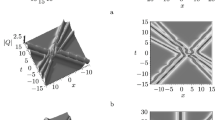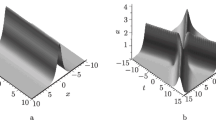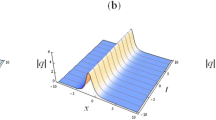Abstract
In this work, we apply the \(\overline{\partial }\)-dressing method to study the mixed Chen–Lee–Liu derivative nonlinear Schrödinger equation (CLL–NLS) with non-normalization boundary conditions. The spatial and time spectral problems associate with CLL–NLS equation which are derived from local \(2 \times 2\) matrix. A CLL–NLS hierachy with source is proposed by using recursive operator. Based on the \(\overline{\partial }\)-equation, the N-solitons of the CLL–NLS equation are constructed by choosing a special spectral transformation matrix. Further more, the explicit two-soliton is obtained.
Similar content being viewed by others
Avoid common mistakes on your manuscript.
1 Introduction
The explicit solutions of integrable models can provide an important guarantee for the analysis of their various properties, so finding a method to solve integrable models extensively is always an important research topic for a long period of time. The nonlinear Schrödinger equation (NLS) is one of the basic equations of quantum mechanics [1]. By now, several versions of DNLS equations were introduced to investigate the effect of high-order perturbations. Among them, there are three celebrate DNLS equations as follows:
DNLS-I equation or Kaup–Newell equation [2]
DNLS-II equation or Chen–Lee–Liu equation [3]
DNLS-III equation or Gerdjikov–Ivanov equation [4]
The DNLS equations have great applications in nonlinear optics and plasma physics. It can be used to describe large amplitude magnetohydrodynamic waves in plasma and also picosecond pulse in single-modle nonlinear fiber.
Chen–Lee–Liu derivative nonlinear Schrödinger equation (CLL-NLS equation) was firstly put forward by Kundu [5]
which is a completely integrable model, and it can be derived from the modified NLS equation which ignores the mean flow term in hydrodynamics [6]. In recent years, many excellent methods have been put forward by the deep study in integrable system, such as Darboux transformation [7, 8], Hirota bilinear method [9,10,11], similarity reduction [12], Riemann-Hilbert approach [13,14,15,16,17] and inverse scattering method [18, 19]. Among these but not limited to these methods, Zhang et al. obtained higher-order solutions of Eq. (1.4), Hu et al. gave spectral analysis of Lax pair and presented the RH problem of Eq. (1.4) [20].
However, as we know, there is still no research work on CLL–NLS equation by using \(\overline{\partial }\)-dressing method. The \(\overline{\partial }\)-dressing method was first proposed by Zakharov and Shabat [21], in subsequent works, this concept have been applied to different types of equations: (1 + 1)-dimensional and (2 + 1)-dimensional integrable differential equations such as KE equation [22], coupled GI equation [23], Sawada-Kotera equation [24] et al.
In this paper, different from considering the normalization boundary condition \(\psi (k) \to I\) at infinite, we mainly consider \(\overline{\partial }\)-equation with non-normalization \(\psi (k) \to D\) at infinite, where \(D\) is a non-degenerate matrix function of \(x\) and \(t\). The spectral problem and hierachies can be obtained by giving boundary condition matrix function \(D\) more general. In Sect. 2, starting from a \(\overline{\partial }\)-equation, we presented the general Lax pair for CLL-NLS equation using the \(\overline{\partial }\)-dressing method. In Sect. 3, we derived CLL-NLS hierarchy with source based on the relation between \(\overline{\partial }\)-dressing transformation matrix and its potential matrix. In Sect. 4, a formula for N-soliton solutions of CLL–NLS equation is constructed and we gave explicit two-soliton solutions for CLL–NLS equation for example.
2 Spectral analysis and Lax pair
2.1 The spatial spectral problem
Consider a matrix \(\overline{\partial }\) problem with a non-normalization boundary condition
where \(D = D(x,t)\) is a non-degenerate matrix function of arbitrary independent variable \(x\) and \(t\), \(\psi (x,t,k)\) and \(R(x,t,k)\) are \(2 \times 2\) matrix, \(R(x,t,k)\) is spectral transform matrix.
Then the Eq. (2.1) admits a solution
where \(C_{k}\) denotes the Cauchy-Green integral operator acting on the left. We can obtain a formal solution of the \(\overline{\partial }\)-problem Eq. (2.1)
There are some necessary notations we need to fix first to making our presentation easy to understand and self-contained. For details refer [25], we define two pairings as follow
Which can be shown to admit properties
For matrix functions \(f(k)\) and \(g(k)\), simple calculation shows that non-normalization \(\overline{\partial }\) problem
In the research of integrable systems, the Lax pairs of nonlinear equations are very important. There are many effective methods emerged base on their Lax pairs such as Darboux transformation, inverse scattering transformation, Riemann–Hilbert method that have been extensively studied. Here we show that spatial-time spectral problems for the general non-normalization boundary equation which can be established. We especially obtain the spatial-time spectral problems of CLL-NLS equation starting from Eq. (2.1).
Proposition 1
Let the transform matrix \(R\) satisfy
where \(\sigma_{3}\) is the Pauli matrix, then the solution \(\psi\) of\(\overline{\partial }\) Eq. (2.1) satisfies the following spatial problem for CLL-NLS Eq. (1.4).
where
and compared with the case where the boundary condition is an identity matrix, Eq. (2.9) satisfied some symmetry conditions as follows
where \(M_{mn}\) represents the \(m\) row and \(n\) column elements of matrix \(M\) , \(D^{ - 1}\) is the inverse matrix of \(D\) .
Remark 1.
Let \(Q\) and \(D\) satisfies
the \(\overline{\partial }\)–Eq. (2.1) leads to a spatial spectral problem for CLL-NLS Eq. (1.4)
where the complex number \(k\) is a associated spectral parameter.
Proof .
Making use of Eqs. (2.3) and (2.7), we obtain
Direct computation gives
Since \(RC_{k} = I - I \cdot (I - RC_{k} ),\) we find
Substituting the Eqs. (2.13–2.14), we find Eq. (2.8). By virtue of Eq. (2.9) and first equation of Eq. (2.10), we have Eq. (2.11).
2.2 The time spectral problem
Proposition 2
Suppose that transform matrix \(R\) satisfies the linear equation
where
which comprises both a polynomial part \(\Omega_{p} (k)\) and a singular part \(\Omega_{s} (k)\) and \(\omega (\xi^{2} )\) is a scalar function. Based on the \(\overline{\partial }\) -Eq. ( 2.1 ), the time spectral problem of CLL-NLS equation can be given as follow
Remark 2.
As \(\omega (\xi^{2} ) = 0,\) Eq. (2.17) reduces to
which together with the spatial spectral Eq. (2.11) gives the Lax pair of the CLL-NLS equation (1.4).
Proof.
In the time spectral problem, we first use the polynomial dispersion relation only \(\Omega = \Omega_{p} = 2ik^{4} \sigma_{3} .\) From Eqs. (2.2), (2.3) and (2.16), we find that
Furthermore, making use of Eq. (2.13), then Eq. (2.19) is changed to
By using Eqs. (2.7), (2.8) and (2.9), we obtain
Hence, we note that \(\psi\) obeys the parity properties
By which, we can show that
Substituting them into Eq. (2.20), we find
By virtue of Eqs. (2.21) and (2.9), we have some calculation results as follow
Substituting Eq. (2.23) into Eq. (2.22) leads to the time-dependent linear equation
On the other hand, we consider the singular dispersion relation \(\Omega_{s}\), similarly, we have
By Eq. (2.2), we can express \(\Omega_{s}\) in another form
Resorting Eqs. (2.2) and (2.5), \(\psi R\Omega_{s} C_{k}\) in Eq. (2.25) satisfies
Hence, we have
By using the relations
we find that
by which, then Eq. (2.25) gives a time-dependent linear equation with the singular dispersion relation
which together with Eq. (2.24) gives time spectral Eq. (2.17).
3 Recursive operators and CLL-NLS hierarchy
In this section, we derive the CLL-NLS hierarchy with source. In order to prove this we define matrix M as following form
which \(M\) is depends on \(x\) and \(t\), then we can prove the following proposition.
Proposition 3
\(Q\) defined by Eq. (2.9) satisfies a coupled hierarchy with a source \(M\).
where
Proof.
Differentiating \(Q\) with respect to \(t\) gives
Because of \(C_{k}\) is the inverse operator of \(\overline{\partial }\) then we have
and clearly
Using Eqs. (2.4) and (3.6), the Eq. (3.5) can be rewritten as follow
From the \(\overline{\partial }\)-Eq. (2.1), we have
which leads to
We further simplify the first term in Eq. (3.7),
Using the condition Eq. (2.15), the first term of Eq. (3.10) can be written as
Hence, using Eqs. (2.4) and (2.15), Eq. (3.7) reduces to the following form
where
Here we shall consider \(\Omega_{p} = \alpha_{n} k^{2n} \sigma_{3} ,\) \(\alpha_{n} =\) constant, then the term
\(- i\left[ {\sigma_{3} ,\left\langle {\psi \Omega \overline{\partial } \psi^{ - 1} } \right\rangle } \right] - i\left[ {\sigma_{3} ,\left\langle {\left( {\overline{\partial } \psi } \right)\Omega \psi^{ - 1} } \right\rangle } \right]\) can be further simplified like
Noticing that \(\Omega_{p} = \alpha_{n} k^{2n} \sigma_{3}\) is an analytic function on the k-plane, and the fact that \(\Omega_{s} \to 0\) as \(k \to 0,\) so we have
Then we get
The \(Q_{t}\) can be express as follows
where \(M^{0}\) is given as Eq. (3.13). By using Eq. (2.11), it can be checked that \(M\left( k \right)\) satisfies the equation
From Eq. (3.18), they satisfy the following equations
which lead to
where
The operator \(\Lambda \cdot\) usually be called as recursion operator. We expand \(\left( {\Lambda - k} \right)^{ - 1}\) in the series
By using \(\overline{\partial } k^{n - j} = \pi \delta \left( k \right)\delta_{j,n + 1} ,j = 1,2,...,\) we can derive that
4 N-soliton solutions of CLL-NLS equation
In this section, we will construct the N-soliton solutions of CLL-NLS equation.
Proposition 4
choose that spectral transform matrix \(R\) as
where \(k_{j}\) and \(\overline{{k_{j} }}\) are \(2N\) discrete spectrals in complex plane \({\mathbb{C}}\) and \(\theta \left( k \right) = k^{2} x + 2k^{4} t.\)
Let \(\widehat{Q} = QD,\) then we have
5 then the CLL-NLS equation have solution
where \(M\) is \(N \times N\) matrices, and \(M^{aug}\) is \(\left( {N + 1} \right) \times \left( {N + 1} \right)\) matrices defined by
Proof.
Substituting Eq. (4.1) into Eq. (4.2) leads to.
Substituting Eq. (4.1) into \(\overline{\partial }\)-Eq. (2.2) and resorting the properties of \(\delta\) function, we can obtain
Replacing \(k\) in Eq. (4.6) with \(k_{n}\), and \(k\) in Eq. (4.7) with \(\overline{{k_{j} }}\), we can obtain linear equations for \(\psi_{11} \left( {k_{n} } \right)\) as follow
where
We further introduce notations
then Eq. (4.10) reduce to linear system in matrix form
From which we can substituting \(\psi_{11}\) into Eq. (4.5), we can obtain
where \(q_{N}\) is given by Eq. (4.4). Clearly Eqs. (2.10) are compatible and admit a solution
By virtue of Eqs. (4.2) and (4.13), we can obtain
Taking the modulus on both sides of above equation, we have \(u = 8\left| {q_{N} } \right|,\) substituting it to Eq. (4.14), we can obtain the N-soliton solution of CLL-NLS equation
Example.
For \(N = 2,\) the formula Eq. (4.15) gives the two-soliton solutions of the CLL-NLS equation that are given by
where
and
where \(w_{1} ,w_{2}\) being two arbitrary constants.
6 Conclusion
In this paper, we introduced the \(\overline{\partial }\)-dressing method. Through the \(\overline{\partial }\)-dressing method starting from a \(\overline{\partial }\)-equation, we presented the spatial-time spectral problems for CLL–NLS equation. Then we derived CLL–NLS hierarchy with source based on the relation between \(\overline{\partial }\)-dressing transformation matrix and its potential matrix, and the spectral problem and hierachies can be obtained by giving boundary condition matrix function \(D\) more general. In the end, we constructed a formula for N-soliton solutions of CLL–NLS equation.
In summary, the \(\overline{\partial }\)-dressing method is powerful for analyzing spectral problem of integrable systems. In our future work, we will continue to using \(\overline{\partial }\)-dressing method and Riemann-Hilbert approach to analyze the asymptotic behaviour for Eq. (1.4) and other integrable system.
Availability of data and material
Not applicable.
References
Benney, D.J., Newell, A.C.: Nonlinear wave envelopes. J. Math. Phys. 46, 133–139 (1967)
Kaup, D.J., Newell, A.C.: An exact solution for a derivative nonlinear Schrödinger equation. J. Math. Phys. 19, 789–801 (1978)
Chen, H.H., Lee, Y.C., Liu, C.S.: Integrability of nonlinear Hamiltonian systems by inverse scattering method. Phys. Scr. 20, 490–492 (1979)
Gerdzhikov, V.S., Ivanov, M.I.: A quadratic pencil of general type and nonlinear evolution equations. II, Hierarchies of Hamiltonian structures. Bulgar. J. Phys. 2, 130–143 (1983)
Kundu, A.: Landau-lifshitz and higher order nonlinear systems gauge generated from nonlinear Schrödinger type equations. J. Math. Phys. 25(12), 3433–3438 (1984)
Dysthe, K.B.: Note on a modification to the nonlinear Schrödinger equation for application to deep water waves. Phys. R. Soc. A-Math. Phys. 369, 105–114 (1979)
Zuo, D.W., Jia, H.X.: Interaction of the nonautonomous soliton in the optical fiber. Optik 127(23), 11282–11287 (2016)
Geng, L., Li, C.: Darboux transformation for the Zn-Hirota systems. Mod. Phys. Lett. B 33(21), 1950246 (2019)
Lou, S.Y.: Soliton molecules and asymmetric solitons in fluid systems via velocity resonance. J. Phys. Commun. 4, 041002 (2020)
Yang, X.Y., Fan, R., Li, B.: Soliton molecules and some novel interaction solutions to the (2+1)-dimensional B-type Kadomtsev–Petviashvili equation. Phys. Scr. 95(4), 045–213 (2020)
Xie, X.Y., Yan, Z.H.: Soliton collisions for the Kundu-Eckhaus equation with variable coefficients in an optical fiber. Appl. Math. Lett. 80, 48–53 (2018)
Lou, S.Y.: Conditional similarity reduction approach: Jimbo–Miwa equation. Chin. Phys. B 10(10), 897 (2001)
Wang, D.S., Wang, X.L.: Long-time asymptotics and the bright N-soliton solutions of the Kundu–Eckhaus equation via the Riemann–Hilbert approach. Nonlinear Anal-Real. 41, 334–361 (2018)
Wen, L., Fan, E.G.: The Riemann-Hilbert approach to focusing Kundu-Eckhaus equation with nonzero boundary conditions. Mod. Phys. Lett. B 34, 2050332 (2019)
Hu, B., Yu, X., Zhang, L.: On the Riemann-Hilbert problem of the matrix Lakshmanan-Porsezian-Daniel system with a AKNS-type matrix Lax pair. Theor. Math. Phys. 210(3), 337–352 (2022).
Zhang, W.G., Yao, Q., Bo, G.Q.: Two-soliton solutions of the complex short pulse equation via riemann-hilbert approach. Appl. Math. Lett. 98, 263–270 (2019)
Zhu, Q.Z., Xu, J., Fan, E.G.: The Riemann-Hilbert problem and long-time asymptotics for the Kundu-Eckhaus equation with decaying initial value. Appl. Math. Lett. 76, 81–89 (2018)
Ma, W.X.: Inverse scattering and soliton solutions of nonlocal reverse-spacetime nonlinear Schrödinger equations. Proc. Am. Math. Soc. 149, 251–263 (2021)
Ablowitz, M.J., Nachman, A.I.: Multidimensional nonlinear evolution equations and inverse scattering. Physica D 18(1–3), 223–241 (1986)
Hu, B., Zhang, L., Zhang, N.: On the Riemann–Hilbert problem for the mixed Chen–Lee–Liu derivative nonlinear Schrödinger equation. J. Comput. Appl. Math. 113393 (2021).
Zakharov, V.E., Shabat, A.B.: A scheme for integrating the nonlinear equations of mathematical physics by the method of the inverse scattering problem J. . Funct. Anal. Appl. 8, 226–235 (1974)
Luo, J., Fan, E.G.: A -dressing approach to the Kundu-Eckhaus equation- ScienceDirect. J. Geom. Phys. 167, 1042911 (2021)
Luo, J., Fan, E.G.: dressing method for the coupled Gerdjikov-Ivanov equation. Appl. Math. Lett. 110, 106589 (2020)
Chai, X., Zhang, Y., Chen, Y.: Application of the -dressing method to a (2+1)-dimensional equation. Theor. Math. Phys. 209, 1717–1725 (2021)
Doktorov, E.V., Leble, S.B.: A dressing method in mathematical physics. Springer, New York (2007)
Funding
This work is supported by National Natural Science Foundation of China under Grant Nos. 12175111 and 11975131, and K. C. Wong Magna Fund in Ningbo University.
Author information
Authors and Affiliations
Contributions
SFS studies conceptualization and writing (review and editing) the manuscript, BL funding acquisition and project administration. All authors approved the final manuscript.
Corresponding author
Ethics declarations
Conflict of interest
The authors declare that they have no competing interests.
Ethics approval
Not applicable.
Consent to participate
Not applicable.
Consent for publication
Not applicable.
Rights and permissions
Open Access This article is licensed under a Creative Commons Attribution 4.0 International License, which permits use, sharing, adaptation, distribution and reproduction in any medium or format, as long as you give appropriate credit to the original author(s) and the source, provide a link to the Creative Commons licence, and indicate if changes were made. The images or other third party material in this article are included in the article's Creative Commons licence, unless indicated otherwise in a credit line to the material. If material is not included in the article's Creative Commons licence and your intended use is not permitted by statutory regulation or exceeds the permitted use, you will need to obtain permission directly from the copyright holder. To view a copy of this licence, visit http://creativecommons.org/licenses/by/4.0/.
About this article
Cite this article
Sun, SF., Li, B. A \(\overline{\partial }\)-dressing method for the mixed Chen–Lee–Liu derivative nonlinear Schrödinger equation. J Nonlinear Math Phys 30, 201–214 (2023). https://doi.org/10.1007/s44198-022-00076-3
Received:
Accepted:
Published:
Issue Date:
DOI: https://doi.org/10.1007/s44198-022-00076-3




